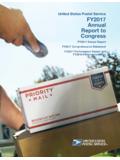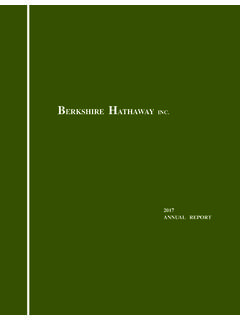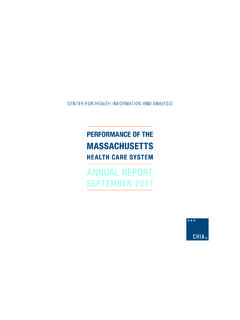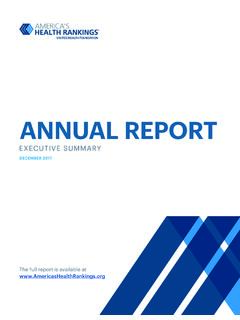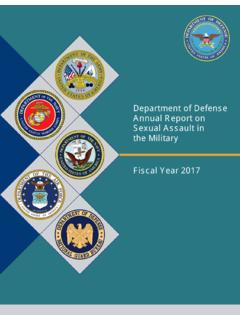Transcription of Electronic Tax Administration Advisory Committee ANNUAL …
1 Electronic Tax Administration Advisory CommitteeJune 2019 ANNUAL REPORTTO CONGRESSP ublication 3415 (Rev. 6-2019) Catalog Number 28110R Department of the Treasury Internal Revenue Service i Electronic TAX Administration Advisory Committee MEMBERS John Ams Shannon Bond John Breyault Luanne Brown Angela Camp John Craig Jenine Hallings Michael Jackman Courtney Kay-Decker Suzanne Kruger Kathy Pickering Phillip Poirier, Jr. (Vice Chair) Lynnette T. Riley Gene Salo John Sapp Joseph Sica Mark Steber Doreen Warren (Chair) ii ETAAC member biographies can be found in Appendix B LETTER FROM THE CHAIR AND VICE CHAIR The Electronic Tax Administration Advisory Committee (ETAAC) is pleased to deliver its 2019 ANNUAL report to Congress. Since the expansion of its Charter in 2016, ETAAC s primary focus continues to be on protecting taxpayers and enhancing their experience. Our 2019 report provides recommendations to identify and prevent Identity Theft Tax Refund Fraud (IDTTRF) and protect and help taxpayers by involving and increasing the awareness of affected stakeholders in our tax system, improving the taxpayer interactions with the IRS and increasing the security of our Electronic tax infrastructure.
2 ETAAC would like to emphasize several key points at the outset of this report . 1. The Security Summit, under the IRS s leadership, continues to make progress in the fight against IDTTRF. Sustaining the Security Summit s ability to detect and prevent IDTTRF will require continued engagement with existing and new partners from both government (federal, state and local) and industry. 2. Congressional funding and support for the Security Summit and ISAC1 remain a key enabler to the ongoing success of these initiatives. 3. The IDTTRF threat will be a challenge for some time to come. In fact, nation-states and cybercriminals are becoming more sophisticated and will continue to make it difficult to detect and stop their criminal activities, which will directly impact legitimate taxpayers trying to meet their tax filing obligations. 4. The implementation of new tax laws, such as the Tax Cut and Jobs Act, requires IRS resources both to implement the substantive elements of any new law and also to analyze and prepare for potential new IDTTRF opportunities created by the new law.
3 5. The commitment and professionalism of the IRS leadership and staff during the government shutdown was exemplary. Notwithstanding the disruption, the IRS prepared and executed contingency plans that minimized the impact of the shutdown on its operations including its efforts to stop IDTTRF. Our report is organized to provide the reader with the opportunity to review key insights at a glance or to go deeper into the supporting details. For a high-level overview, read the Executive Summary following this Letter and the Summary List of ETAAC 2019 Recommendations. To understand the details underlying our 2019 recommendations, review the Current Environment for IDTTRF & Cybersecurity and Detailed Support for ETAAC 2019 Recommendations sections. (Page numbers for each area and recommendations are listed in the Table of Contents). 1 ISAC refers to the IDTTRF Information Sharing and Analysis Center, which is further described in the About the Security Summit section of this report .
4 Iii The eighteen-member ETAAC team spends thousands of volunteer hours to research and consider its recommendations. Our intention is to recognize the remarkable progress of the Security Summit collaborative effort under the IRS s leadership and with the significant support and commitment of states and industry, and to identify potential opportunities to build on its success. We appreciate the support and interest that Congress has expressed in our work. Likewise, we appreciate the support of the IRS s employees and leadership, including their responses to our numerous requests and questions. We want to recognize their continued commitment to the Security Summit and the American taxpayer. Through the Security Summit, the IRS has brought together disparate stakeholders to protect the integrity of our tax system. The Security Summit is no small achievement and is a living demonstration of the effectiveness and benefits of taking on common challenges with a collaborative and unified approach.
5 Finally, the ETAAC Chair has been involved in the Security Summit from its very beginning as a state representative. Over the past several years, she has seen firsthand the steady increase in collaboration, trust and respect of the government and private sector participants involved in this monumental endeavor. She is proud to recognize the solid foundation built by the Security Summit, and believes that the effort to prevent IDTTRF and protect taxpayers will continue to bear fruit so long as all stakeholders continue to collaborate and stay focused on the common objective of maintaining the integrity of our tax system. Respectfully submitted, Doreen Warren ETAAC Chair Phillip L. Poirier, Jr. ETAAC Vice Chair iv EXECUTIVE SUMMARY Identity Theft Tax Refund Fraud and Information Security is our primary focus This report is the third since the ETAAC s charter was extended to include an evaluation of the Security Summit initiative and the prevention of IDTTRF.
6 The ETAAC 2017 and 2018 ANNUAL Reports to Congress included 22 and 19 recommendations, respectively, concerning IDTTRF and the Security Summit s activities. For 2019, ETAAC made a conscious decision to narrow its focus to a smaller number of critical recommendations. After considering over 25 potential topics, we arrived at ten recommendations falling under three themes: Strengthening the Security Summit and ISAC Improving Security Protecting and Enabling Taxpayers Our report also includes an update on the IRS s efforts to increase Electronic filing. The Security Summit continues to make progress against these ongoing risks IDTTRF threatens the integrity of our voluntary compliance tax system at both the federal and state levels. The wholesale theft of huge volumes of personal information has provided criminals and other bad actors with detailed and accurate taxpayer information. Our sophisticated adversaries can use this information to create and file returns that look almost identical to those of the legitimate taxpayer.
7 Unfortunately, there is no silver bullet that makes it easy for the IRS to spot these fraudulent returns among the hundreds of millions of legitimate returns. This is a critical time. To protect our tax system, the Security Summit and ISAC must continue to drive progress with a unified and collaborative approach among all of the Fortunately, the IRS, states and private industry have made substantial funding and personnel commitments to the Security Summit and ISAC. Ongoing funding and investment in programs, technology and staff will be critical to the continued maturation, evolution and success of the Security Summit and ISAC. Focus of ETAAC s 2019 Recommendations ETAAC s 2019 recommendations fall under three broad themes: 1. Strengthen the Security Summit and ISAC by: Funding the ISAC Enacting an IDTTRF exception to IRC Section 6103 Increasing the engagement of ISAC members Integrating the Payroll Community more fully into the Security Summit 2 The About the IRS Security Summit section of this report reviews the key accomplishment and current focus/priorities of the Security Summit and ISAC.
8 V Piloting a Financial Services Company (FSC) Collaboration Space in the ISAC 2. Improve the security in key areas of our tax system by: Assessing the state of information security in the tax professional community Granting the IRS the authority to establish and enforce security standards 3. Protect & enable taxpayers by: Developing and expanding channels for identity proofing Collaborating with Security Summit members to identify and pilot emerging approaches for identity verification Engaging with the Security Summit to improve the IRS Taxpayer Protection Program s taxpayer experience Congressional support is needed in some key appropriation and policy areas The ETAAC 2019 report calls for Congress to take appropriations or policy actions in several key areas to enable the IRS to fight IDTTRF and increase information security. First, from an appropriations perspective, ETAAC recommends that Congress provide sufficient funding for the IRS to staff and execute IRS, Security Summit and ISAC priorities identified in this report .
9 This request includes our recommendation to fund the ISAC. (See Recommendation #1) Second, from a policy perspective, ETAAC recommends that Congress take legislative action in two key areas: Information Sharing. Congress should create a carefully targeted exception under Internal Revenue Code (IRC) Section 6103 to permit the use and disclosure of federal tax information to enable more effective information sharing to identify and prevent IDTTRF. (See Recommendation #2) Security Standards. Congress should grant the IRS the authority to establish and enforce security standards for our tax system. (See Recommendation #7) Closing Thoughts Clear IRS ownership and accountability for information security The IRS continues to demonstrate its commitment to improve information security across our tax system and to fight IDTTRF. The success of these efforts requires effective and efficient management based on clear internal ownership and accountability within the IRS.
10 In the area of information security, the IRS can continue to improve its effectiveness in developing and updating security requirements and providing consistent, clear, concise and actionable guidance to and education for tax professionals and e-file program participants. vi As noted in previous recommendations,3 ETAAC believes that the IRS must have clearer internal ownership and accountability for establishing or enforcing existing or new security standards and programs. This issue is equally present in the IRS s broader management and execution of Security Summit and ISAC initiatives that cross multiple internal IRS businesses, divisions and functions such as the integration of the payroll community into the Security Summit as further described in this report . Stakeholder engagement and IRS leadership The Security Summit s unified and collaborative approach to detect and prevent IDTTRF necessarily involves our entire voluntary compliance tax system.










